- Home
- Stephen Baxter
Manifold: Space Page 2
Manifold: Space Read online
Page 2
"Your nation has turned inward," Nemoto said. "Shrunk back."
"Maybe. We just have different priorities now." In the U.S., flights into space had become a hobby of old men and women, dreams of an age of sublimated warfare that had left behind only images of charmingly antique rocket craft, endlessly copied around the data nets. Nothing to do with now.
"Then why do you continue to argue, to talk, to expose yourself to ridicule?" she said.
"Because..." Because if nobody thinks it, it definitely won't happen.
She was smiling at him; she seemed to understand. "The kokuminsei, the spirit of your people, is asleep," she said. "But in you, and perhaps others, curiosity burns strong. I think we two should defy the spirit of our age."
"Why have you brought me here?"
"I am seeking to resolve a koan," she said. "A conundrum that defies logical analysis." Her face lost its habitual smile, for the first time since they'd met. "I need a fresh look – a perspective from a big thinker, someone like you. And..."
"Yes?"
"I am afraid, I think," she said. "Afraid for the future of the species."
The tractor worked its way across the Moon, following a broad, churned-up path. Nemoto offered him more food.
The tractor drew up at an air lock at the outskirts of Edo. A big NASDA symbol was painted on the lock: NASDA for Japan's National Space Development Agency. With a minimum of fuss, Nemoto led Malenfant through the air lock and into Edo, into a colony on the Moon.
Here, at its periphery, Edo was functional. The walls were bare, of fused, glassy regolith. Ducts and cables were stapled to the roof. People wore plain, disposable paper coveralls. There was an air of bustle, of heavy industry.
Nemoto led him through Edo, a gentle guided tour. "Of course the station is a great achievement," she said. "No less than ninety-five flights of our old H-2 rockets were required to ferry accommodation modules and power plants here. We build beneath the regolith, for shelter from solar radiation. We bake oxygen from the rocks, and mine water from the polar permafrost..."
At the center of the complex, Edo was a genuine town. There were public places: bars, restaurants where the people could buy rice, soup, fried vegetables, sushi, sake. There was even a tiny park, with shrubs and bamboo grass; a spindly lunar-born child played there with his parents.
Nemoto smiled at Malenfant's reaction. "At the heart of Edo, ten meters beneath lunar regolith, there are cherry trees. Our children study beneath their branches. You may stay long enough to see ichi-buzaki, the first state of blossoming."
Malenfant saw no other Westerners. Most of the Japanese nodded politely. Many must have known Nemoto – Edo supported only a few hundred inhabitants – but none engaged her in conversation. His impression of Nemoto as a loner, rather eccentric, was reinforced.
As they passed one group he heard a man whisper, "Wah! Gaijin-kusai."
Gaijin-kusai. The smell of foreigner. There was laughter.
Malenfant spent the night in what passed for a ryokan, an inn. His apartment was tiny, a single room. But, despite the bleak austerity of the fused-regolith walls, the room was decorated Japanese style. The floor was tatami – rice-straw matting – polished and worn with use. A tokonoma, an alcove carved into the rock, contained an elaborate data net interface unit; but the owners had followed tradition and had hung a scroll painting there – of a dragonfly on a blade of grass – and some flowers, in an ikebana display. The flowers looked real.
There was a display of cherry blossom leaves fixed to the wall under clear plastic. The contrast of the pale living pink with the gray Moon rock was the most beautiful thing he had ever seen.
In this tiny room he was immersed in noise: the low, deep rumblings of the artificial lungs of the colony, of machines plowing outward through the regolith. It was like being in the belly of a huge vessel, a submarine. Malenfant thought wistfully of his own study: bright Iowa sunlight, his desk, his equipment.
Edo kept Tokyo time, so Malenfant, here on the Moon, suffered jet lag. He slept badly.
Rows of faces.
"How are we to populate the Galaxy? It's actually all a question of economics." Over Malenfant's head a virtual image projected in the air of the little theater, its light glimmering from the folded wooden walls.
Malenfant stared around at the rows of Japanese faces, like coins shining in this rich brown dark. They seemed remote, unreal. Many of these people were NASDA administrators; as far as he could tell there was nobody from Nishizaki senior management here, nominally his sponsors for the trip.
The virtual was a simple schematic of stars, randomly scattered. One star blinked, representing the Sun.
"We will launch unmanned probes," Malenfant said. Ships, little dots of light, spread out from the toy Sun. "We might use ion rockets, solar sails, gravity assists – whatever. The first wave will be slow, no faster than we can afford. It doesn't matter. Not in the long term.
"The probes will be self-replicating: von Neumann machines, essentially. Universal constructors. Humans may follow, by such means as generation starships. However it would be cheaper for the probes to manufacture humans in situ, using cell synthesis and artificial-womb technology." He glanced over the audience. "You wish to know if we can build such devices. Not yet. Although your own Kashiwazaki Electric has a partial prototype."
At that there was a stir of interest, self-satisfied.
As his virtual light show continued to evolve, telling its own story, he glanced up at the walls around him, at the glimmer of highlights from the wood. This was a remarkable place. It was the largest structure in Edo, serving as community center and town hall and showpiece, the size of a ten-story building.
But it was actually a tree, a variety of oak. The oaks were capable of growing to two hundred meters under the Moon's gentle gravity, but this one had been bred for width, and was full of intersecting hollowed-out chambers. The walls of this room were of smooth-polished wood, broken only subtly by technology – lights, air vents, virtual-display gear – and the canned air here was fresh and moist and alive.
In contrast to the older parts of Edo – all those clunky tunnels – this was the future of the Moon, the Japanese were implicitly saying. The living Moon. What the hell was an American doing here on the Moon, lecturing these patient Japanese about colonizing space? The Japanese were doing it, patiently and incrementally working.
But yes, incrementally: that was the key word. Even these lunar colonists couldn't see beyond their current projects, the next few years, their own lifetimes. They couldn't see where this could all lead. To Malenfant, that ultimate destination was everything.
And, perhaps, Nemoto and her strange science would provide the first route map.
The little probe images had reached their destination stars.
"Here is the heart of the strategy," he said. "A target system, we assume, is uninhabited. We can therefore program for massive and destructive exploitation of the system's resources, without restraint, by the probe. Such resources are useless for any other purpose, and are therefore economically free to us. And so we colonize, and build."
More probes erupted from each of the first wave of target stars, at greatly increased speeds. The probes reached new targets; and again, more probes were spawned, and fired onward. The volume covered by the probes grew rapidly; it was like watching the expansion of gas into a vacuum.
"Once started, the process is self-directing, self-financing," he said. "It would take, we think, ten to a hundred million years for the colonization of the Galaxy to be completed in this manner. But we must invest merely in the cost of the initial generation of probes. Thus, the cost of colonizing the Galaxy will be less, in real terms, than that of our Apollo program of fifty years ago."
His probes were now spreading out along the Galaxy's spiral arms, along lanes rich with stars. His Japanese audience watched politely.
But as he delivered his polished words, he thought of Nemoto and her tantalizing hints of otherness –
of a mystery that might render all his scripted invective obsolete – and he faltered.
Trying to focus, feeling impatient, he closed with his cosmic-destiny speech. "This may be a watershed in the history of the cosmos. Think about it. We know how to do this. If we make the right decisions now, life may spread beyond Earth and Moon, far beyond the Solar System, a wave of green transforming the Galaxy. We must not fail..." And so on.
Well, they applauded him kindly enough. But there were few questions.
He got out, feeling foolish.
The next day Nemoto said she would take him to the surface, to see her infrared spectroscopy results at first hand.
They walked through the base to a tractor air lock and suited up once more. The infrared station was an hour's ride from Edo.
A kilometer out from Edo itself, the tractor passed one of the largest structures Malenfant had yet seen. It was a cylinder perhaps 150 meters long, 10 wide. It looked like a half-buried nuclear submarine. The lunar surface here was scarred by huge gullies, evidently the result of strip-mining. Around the central cylinder there was a cluster of what looked like furnaces, enclosed by semitransparent domes.
"Our fusion plant," Nemoto said. "Edo is powered by the fusion of deuterium, the hydrogen isotope, with helium-3."
Malenfant stared out with morbid interest. Here, as in most technological arenas, the Japanese were way ahead of Americans. Twenty percent of U.S. power now came from the fusion of two hydrogen isotopes, deuterium and tritium. But hydrogen fusion processes, even with such relatively low-yield fuel, had turned out to be unstable and expensive: high-energy neutrons smashed through reactor walls, making them brittle and radioactive. The Japanese helium-3 fusion process, by contrast, produced charged protons, which could be kept away from reactor walls with magnetic fields.
However, the Earth had no natural supply of helium-3.
Nemoto waved a hand. "The Moon contains vast stores of helium-3, locked away in deposits of titanium minerals, in the top three meters of the regolith. The helium came from the Sun, borne on the solar wind; the titanium acted like a sponge, soaking up the helium particles. We plan to begin exporting the helium to Earth."
"I know." The export would make Edo self-sufficient.
She smiled brightly, young and confident in the future.
Out of sight of Edo, the tractor passed a cairn of piled-up maria rubble. On the top there was a sake bottle, a saucer bearing rice cakes, a porcelain figure. There were small paper flags around the figure, but the raw sunlight had faded them.
"It is a shrine," Nemoto explained. "To Inari-samma, the Fox God." She grinned at him. "If you close your eyes and clap your hands, perhaps the kami will come to you. The divinities."
"Shrines? At a lunar industrial complex?"
"We are an old people," she said. "We have changed much, but we remain the same. Yamato damashi – our spirit – persists."
At length the tractor drew up to a cluster of buildings set on the plain. This was the Nishizaki Heavy Industries infrared research station.
Nemoto checked Malenfant's suit, then popped the hatch.
Malenfant climbed stiffly down a short ladder. As he moved, clumsily, he heard the hiss of air, the soft whirr of exoskeletal multipliers. These robot muscles helped him overcome the suit's pressurization and the weight of his tungsten antiradiation armor.
His helmet was a big gold-tinted bubble. His backpack, like Nemoto's, was a semitransparent thing of tubes and sloshing water, six liters full of blue algae that fed off sunlight and his own waste products, producing enough oxygen to keep him going indefinitely – in theory.
Actually Malenfant missed his old suit: his space shuttle EMU, extravehicular mobility unit, with its clunks and whirrs of fans and pumps. Maybe it was limited compared to this new technology. But he hated to wear a backpack that sloshed, for God's sake, its mass pulling him this way and that in the low gravity. And his robot muscles – amplifying every impulse, dragging his limbs and tilting his back for him – made him feel like a puppet.
He dropped down the last meter; his small impact sent up a little spray of dust, which fell back immediately.
And here he was, walking on the Moon.
He walked away from the tractor, suit whirring and lurching. He had to go perhaps a hundred meters to get away from tractor tracks and footsteps.
He reached unmarked soil. His boots left prints as crisp as if he had stepped out of Apollo 11.
There were craters upon craters, a fractal clustering, right down to little pits he could barely have put his fingertip into, and smaller yet. But they didn't look like craters – more like the stippling of raindrops, as if he stood in a recently plowed and harrowed field, a place where rain had pummeled the loose ground. But there had been no rain here, of course, not for four billion years.
The Sun cast brilliant, dazzling light. Otherwise the sky was empty, jet black. But he was a little surprised that he had no sense of openness, of immensity all around him, unlike a desert night sky at home. He felt as if he were on a darkened stage, under a brilliant spotlight, with the walls of the universe just a little way away, just out of view.
He looked back at the tractor, with the big red Sun of Japan painted on its side. He thought of a terraformed Moon, of twin blue worlds. He felt tears, hot and unwelcome, prickle his eyes. Damn it. We were here first. We had all this. And we let it go.
Nemoto waited for him, a small figure on the Moon's folded plain, her face hidden behind her gold-tinted bubble of glass.
She led him into the cluster of buildings. There was a small fission power plant, tanks of gases and liquids. A living shelter was half buried in the regolith.
The center of the site was a crude cylindrical hut, open to the sky, containing a battery of infrared sensors and computer equipment. The infrared detectors themselves were immersed in huge vessels of liquid helium. Robots crawled between the detectors, monitoring constantly, their complex arms stained by moondust.
Nemoto walked up to a processor control desk. A virtual image appeared, hovering over the compacted regolith at the center of the hut. The virtual was a ring of glistening crimson droplets, slowly orbiting.
"Here is a summary of my survey of the asteroid belt," Nemoto said. "Or 'belts,' I should say, for there are gaps between the sub-belts – the Kirkwood gaps, swept clear by resonances with Jupiter's gravity field." The Kirkwood gaps were dark bands, empty of crimson drops. "Nishizaki Heavy Industries is very interested in asteroids. There is a mine in Sudbury, Ontario, which for a long time was a rich source of nickel. The nickel seam is disc-shaped. It is almost certainly the scar of an ancient asteroid collision with the Earth."
"Mineral extraction, then."
"There is a scheme to retrieve a fragment of the asteroid Geographos, which crosses Earth's orbit. We may cleave it with controlled explosions. Perhaps we can deliver fragments to orbit, using lunar gravity assists and grazes against the Earth's atmosphere. Or we may initiate a controlled impact with the Moon. This exercise alone would yield more than nine hundred billion dollars' worth of nickel, rhenium, osmium, iridium, platinum, gold – so much, in fact, the planet's economy would be transformed, making estimates of wealth difficult."
Malenfant walked around the instrument hut. The novelty of his moonwalk was wearing off; his suit scratched, his helmet was hot, and his condom was itching. "Nemoto, it's time you got to the point."
"The koan," she said. The virtual ring shone in her visor, making her face invisible. "Let us look at the stars."
She took his gloved hand in hers – through the thick layers of glove he could barely feel the pressure of her fingers – and she led him out of the building. The virtual asteroid ring, eerily, followed them out.
They stood in the deep shadow of the structure. With a motion, she indicated he should lift his visor.
He raised his head so he couldn't see the ground or the buildings, and he turned around and around, as he used to as a kid, on the darkest moonless nights bac
k home.
The stars, of course: thousands of them, peppering the sky all around him, crowding out the bright-star constellations seen from Earth. And now, at last, came that elusive feeling of immensity. From the Moon it was much easier to see that he was just a mote clinging to a round ball of rock, spinning endlessly in an infinite, three-dimensional starry sky.
"Look." Nemoto, pointing, swept out an arc of the sky, where dusty light shone.
Despite the crowding stars, Malenfant recognized one or two constellations – Cygnus and Aquila, the swan and the eagle. And, where she pointed, a river of light ran through the constellations, a river of stars. It was the Milky Way: the Galaxy, the disc of stars in which Sol and all its planets were embedded, seen edge-on and turned into a band of light that wrapped around the sky. But, as it passed through Cygnus and Aquila, that band of light seemed to split into two, twin streams separated by a dark gap. In fact the rift was a shadow cast by dark clouds blocking the light from the star banks behind.
Nemoto pointed. "See how the darkness starts out narrow in Cygnus, then broadens in Aquila, sweeping wider through Serpens and Opiuchus. This is the effect of perspective. We are seeing a band of dust as it comes from the distance in Cygnus, passing closest to the Sun in Aquila and Opiuchus. Malenfant, we live in a spiral arm of this Galaxy – a small fragment, in fact, called the Orion Arm. And spiral arms typically have lanes of dust on their inside edges."
"Like that one."
"Yes. That is the inner edge of our spiral arm, hanging in the sky for all to see." Her shadowed eyes glimmered, full of starlight. "It is possible to make out the Galaxy's structure, you see: to witness that we are embedded in a giant spiral of stars – even with the naked eye. This is where we live."
"Why are you showing me this?"
"Look at the Galaxy, Malenfant. It appears to be a giant machine – no, an ecology – evolved to make stars. And there are hundreds of millions of galaxies beyond our own. Is it really conceivable, given all of that immensity, all that structure, that we are truly alone? That life emerged here, and nowhere else?"

 The Martian in the Wood
The Martian in the Wood THE H-BOMB GIRL
THE H-BOMB GIRL World Engine
World Engine Titan n-2
Titan n-2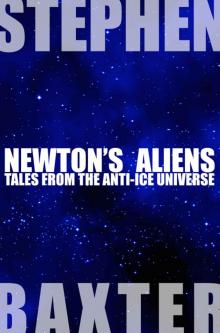 Newton's Aliens: Tales From the Anti-Ice Universe
Newton's Aliens: Tales From the Anti-Ice Universe Exultant
Exultant Manifold: Origin
Manifold: Origin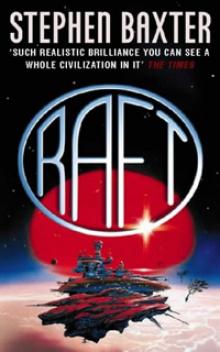 Raft xs-1
Raft xs-1 Bronze Summer n-2
Bronze Summer n-2 Transcendent
Transcendent Stone Spring
Stone Spring Coalescent
Coalescent The Medusa Chronicles
The Medusa Chronicles Origin m-3
Origin m-3 Silverhair tm-1
Silverhair tm-1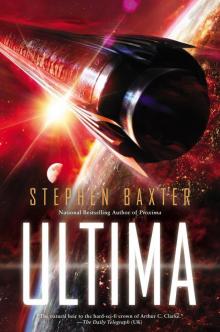 Ultima
Ultima Voyage n-1
Voyage n-1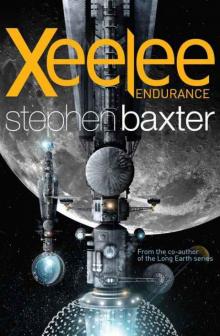 Xeelee: Endurance
Xeelee: Endurance Space m-2
Space m-2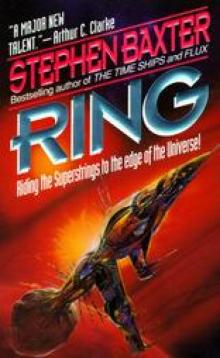 Ring xs-4
Ring xs-4 Raft
Raft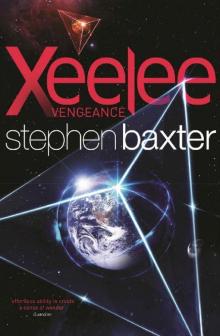 Xeelee: Vengeance
Xeelee: Vengeance Iron Winter n-3
Iron Winter n-3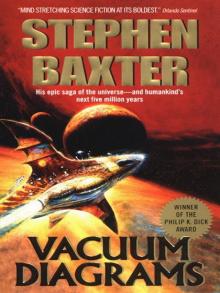 Vacuum Diagrams
Vacuum Diagrams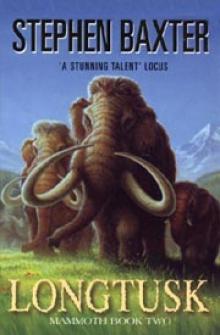 Longtusk tm-2
Longtusk tm-2 Proxima
Proxima Evolution
Evolution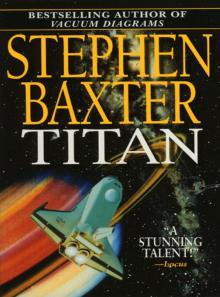 Titan
Titan Last and First Contacts (Imaginings)
Last and First Contacts (Imaginings) Emperor
Emperor The Massacre of Mankind
The Massacre of Mankind Starfall
Starfall Doctor Who - The Wheel of Ice
Doctor Who - The Wheel of Ice Longtusk
Longtusk Silverhair
Silverhair Conqueror tt-2
Conqueror tt-2 Flood
Flood Flood f-1
Flood f-1 Emperor tt-1
Emperor tt-1 Moonseed
Moonseed Conqueror
Conqueror Timelike Infinity xs-2
Timelike Infinity xs-2 The Ghost Pit
The Ghost Pit Xeelee: An Omnibus: Raft, Timelike Infinity, Flux, Ring
Xeelee: An Omnibus: Raft, Timelike Infinity, Flux, Ring Weaver tt-4
Weaver tt-4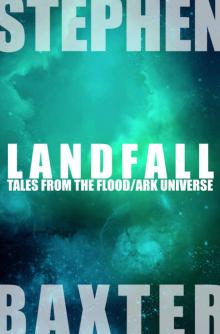 Landfall: Tales From the Flood/Ark Universe
Landfall: Tales From the Flood/Ark Universe Ark
Ark Emperor: Time’s Tapestry Book One
Emperor: Time’s Tapestry Book One Space
Space Icebones
Icebones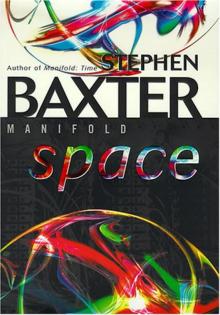 Manifold: Space
Manifold: Space Navigator
Navigator Obelisk
Obelisk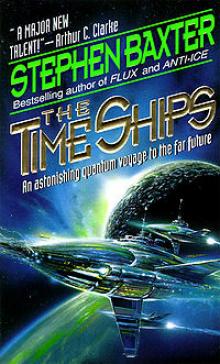 The Time Ships
The Time Ships Bronze Summer
Bronze Summer Resplendent
Resplendent Moonseed n-3
Moonseed n-3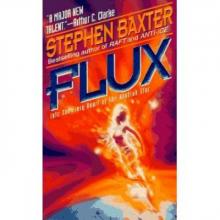 Flux xs-3
Flux xs-3 Transcendent dc-3
Transcendent dc-3 Icebones tm-3
Icebones tm-3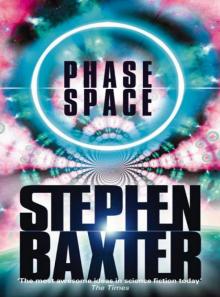 Phase Space
Phase Space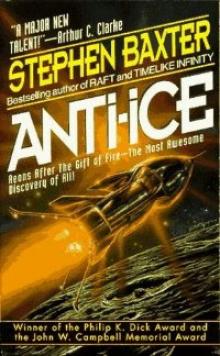 Anti-Ice
Anti-Ice Weaver
Weaver Voyage
Voyage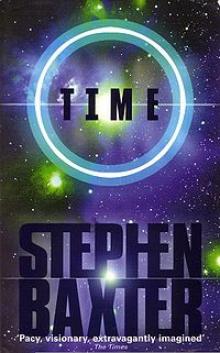 Time m-1
Time m-1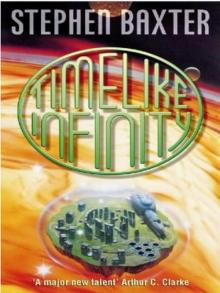 Timelike Infinity
Timelike Infinity Exultant dc-2
Exultant dc-2 Coalescent dc-1
Coalescent dc-1 Navigator tt-3
Navigator tt-3